If your work involves making long rip cuts along the length of the wood, then a Table Saw is the only choice. A Table Saw has a spinning vertical disk blade. But the interesting thing about the blade is it is fixed in a place on a large table surface. So, we don’t move the blade to make cuts but instead, move the wood (or any other material) along the surface of the table. While regular Table Saw Blades are suitable only for cutting wood (plywood, hardwood, timber, etc.), you can change the blade and use the saw to cut other types of material as well (plastic, metal, glass, etc.). But what are the different types of Table Saw Blades available?
In this guide, we will focus on this aspect of Table Saws i.e., take a look at common types of table saw blades. But before that, we need to understand a few basic terminologies associated with Table Saws and their blades.
Basic Terms of Table Saw Blades
1. Tooth
The “Tooth” of a Table Saw Blade is the actual sharp part that makes the cut in the material. Regular teeth are made up of steel but you can get several types of coatings such as nickel, carbide, etc. to make them durable, strong, etc.
2. Teeth Per Inch (TPI)
This is a very important term to consider while purchasing a Table Saw Blade. Teeth Per Inch or TPI indicates the number of teeth the blade has in an inch. A lower TPI count means fewer teeth in an inch’s space and a larger gap between the teeth. So, this type of blade can make fast cuts but the surface will be rough.
Cuts with higher TPI count blades are slightly slower but the surface is much smoother.
3. Gullet
The gap between adjacent teeth is Gullet. The scoop shape of the gullet is critical as it helps in airflow over the blade (keeps the blade cool) and also carries sawdust away from the cut.
4. Bevel
This is the angle of the top of the teeth. Normal angles lie between 10° and 20°. But hi-angle bevels are greater than 25°. Even higher angles such as 40° are also possible for super clean cuts. But the disadvantage of higher bevel angles is the teeth become dull very quickly.
5. Grind
This is a very important design aspect of the blade. The “Grind” of a blade determines the shape of the teeth, how they are laid out, what’s their angle, and many other parameters.
The five basic grind types are:
- Flat Top Grind (FTG): This is the basic type. The top edges of the teeth are flat and square. These teeth are also known as Rakers. FTG teeth act like a chisel chopping through the surface.
- Alternate Tooth Bevel (ATB): The next popular grind style is ATB. Here, the top of the teeth has a bevel angle and every other tooth of the blade leans in opposite direction with the same bevel.
- Combination (ATBR): This is a combination of FTG ad ATB grind styles. In a typical 50-teeth blade, we have 10 sets with 5 teeth in each set. Of the 5 teeth, four are ATB style teeth while one is FTG style tooth.
- Trapezoidal Chip Grind (TCG): In this style, the teeth alternate between FTG style and chamfered teeth (with a trapezoidal shape). They are also known as Triple Chip Grind teeth.
- Hi-Angle Alternate Tooth Bevel (Hi-ATB): This is similar to the ATB style except the bevel angle is higher than 25°.
6. Kerf
This is the thickness of the cutline left by the blade on the material. Thin Kerf Blades have very thin kerfs, usually 3/32-inch thickness. But Full Kerf Blades have about 1/8-inch thickness.
Types of Table Saw Blades
1. Rip Blade
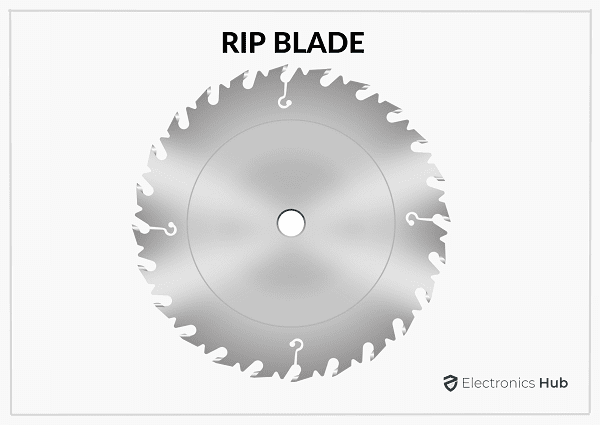
Rip Blades or Ripping Blades are designed specifically for making Rip Cuts. Most Rip Blades help you cut the wood along its grain but you can also use them for occasional crosscuts as well.
While performing a Rip Cut, we are moving with the grain cutting through the fibers of the wood. This means the blade faces significantly less resistance.
Hence, we often find Rip Blades with lower teeth count, usually anywhere between 10 to 30. The most popular and common Rip Blades have around 20 teeth with wide gullets.
Remember, a lower teeth count means a rough surface and a higher teeth count means a smoother surface (and less clean-up later).
Coming to the “grind” of Rip Blades, they have a Flat Top Grind (FTG). This type of blade can even cut through hardwoods quickly.
2. Crosscut Blade
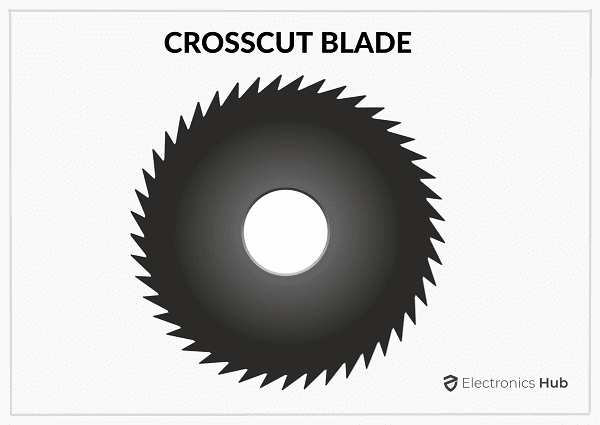
A Crosscut blade is designed for this. We know going against the grain means more resistance. Hence, Crosscut Blades often have higher teeth count, anywhere from 60 to 90.
Also, these teeth are small in size. So, when you combine small teeth in higher quantities, the surface of the wood after the cuts is much smoother (as it removes less material) when compared to a Rip Blade.
When sawing wood across the grain, you could face an exit tear-out. Hence, most crosscut blades use an Alternate Tooth Bevel (ATB) type grind to provide a shearing action.
3. General Purpose Blade
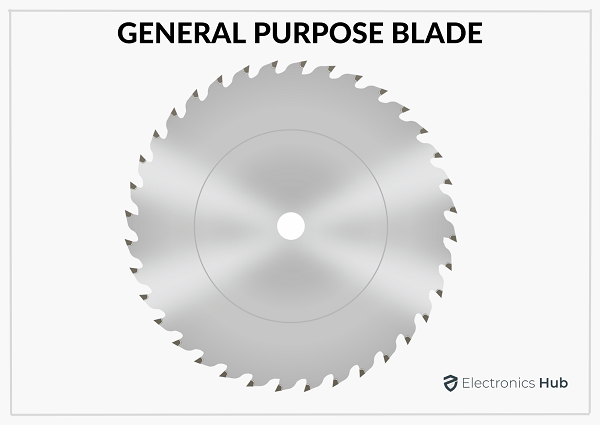
From the above discussion, the unique features of Rip Blades and Crosscut Blades are lower teeth count and beveled teeth respectively. A General Purpose Blade has both of these elements.
Most General Purpose Blades or All-purpose blades have 40 teeth with alternate beveling. The gullets on this blade are slightly deeper than what you find on a Combination Blade, which we are going to see next.
Hence, you can make both Rip Cuts and Crosscuts with this blade. But remember that the crosscuts from these blades are decent but the wood burn on rip cuts.
When you buy a Table Saw, chances are this is the type of blade you get. This became the “standard” table saw blade as it can work for many applications. It doesn’t perform the best in both cuts but you have to consider this blade as a “general purpose” blade.
4. Combination Blade
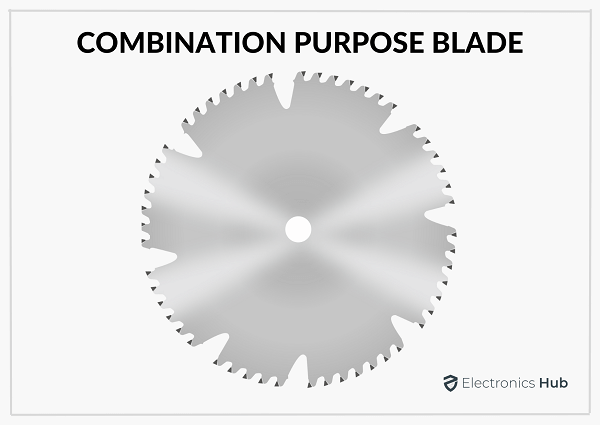
A Combination Blade, as the name suggests, is a combination of a Rip Blade and a Crosscut Blade. 50-tooth Combination Blades are quite popular.
These 50 teeth are arranged in 10 sets with 5 teeth in each set. Of the 5 teeth, four are “Crosscut” type ATB teeth with bevels while one is the “Rip” type FTG teeth with large gullets. As FTG teeth are also known as Rakers, the Combination Blade is often called ATBR Blade.
If you don’t have access to a Modern General Purpose Blade, then you can use the older Combination Blade. Note that both these blades can make Rip Cuts as well as Crosscuts. We recommend the 40-tooth General Purpose Blade over the 50-tooth Combination Blade.
Rip Cuts using a Combination Blade are much quicker than a stand-alone Rip Blade. However, Crosscuts aren’t as smooth as you get them with a Crosscut Blade.
5. Trapezoidal Chip Grind Blade
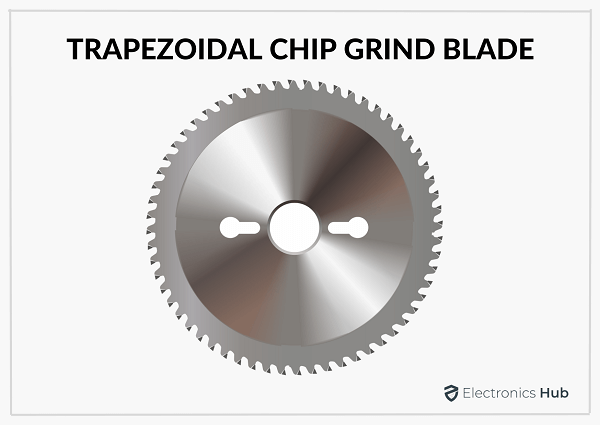
We generally use TCG blades on non-wooden materials such as plastic, acrylic, non-ferrous metals, etc.
6. Dado Blade
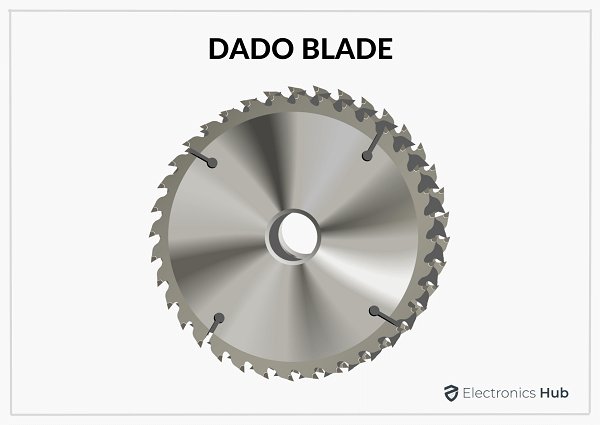
Table Saws have a special type of blade that help you make these types of cuts. They are Dado Blades. Generally, we say a “Dado Blade Set” as it has more than one blade to make a Dad Cut.
A typical Dado Blade Set consists of two exterior Combination Blades with ATBR Grind and an interior Chipper Blade with FTG Grind.
The two outside blades help in making the outline cuts that form the Dado, Rabbet, or Groove while the inside blade helps in chipping the material by going through all the way.
Depending on the size and width of the cut you want to make, you can stack more Chipper Blades between the exterior blades with the necessary spacers.
If you join woods, then a Dado Blade Set is very useful as it allows you to make grooves, dado, or rabbet without much effort. Make sure that your table saw supports a Dado Blade Set as some models won’t have the arbor long enough to fit Dado Blade Sets.
7. Thin Kerf Blade
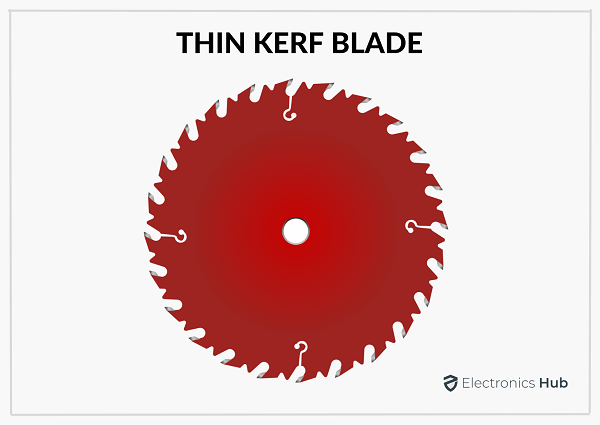
A typical Full Kerf Blade can make about 1/8-inch-thick cuts. A Thin Kerf Blade on the other hand can make about 3/32-inch-thick cuts.
As Thin Kerf Blades are very thin, they don’t need high power to make the cuts. The amount of wood wasted while cutting is less. Also, the sawdust produced by Thin Kerf Blades is very less.
The main application of Thin Kerf Blades is to make thin-strip Rip Cuts with very precise widths. These blades generally have high teeth count or Teeth Per Inch (TPI) and this results in smoother surfaces. The blades of Thin Kerf Blades are carbide-tipped.
8. Hi-ATB Blade
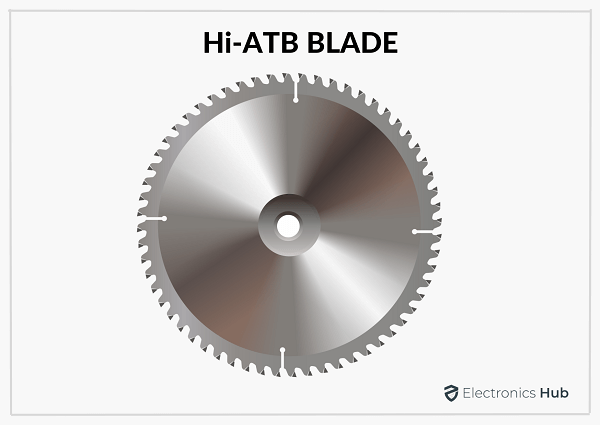
A Hi-ATB Blade is similar to a regular ATB Blade except for the angle of the bevel is 25° or more. Due to the shape and angle of the teeth in Hi-ATB Blades, they are useful in making precision cuts.
Also, these blades don’t cause severe tear-out of the material when compared to other types of Table Saw Blades. The shape of the teeth of Hi-ATB Blades makes them suitable for delicate items.
9. Glue-Line Rip Blade
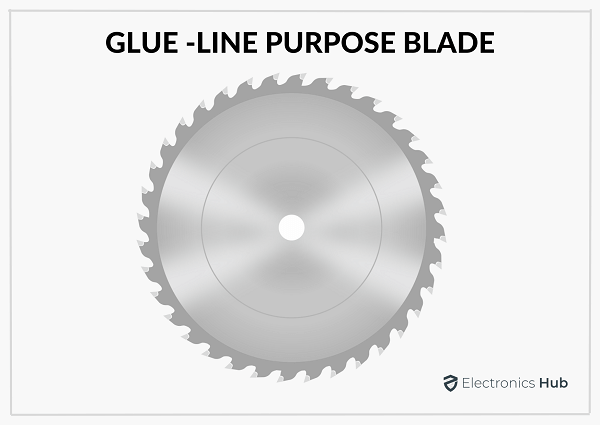
The key difference between a regular Rip Blade and a Glue-line Rip blade is the type of grind they use. While Rip Blades have teeth with Flat Top Grind (FTG), the Glue-line Rip Blades have teeth with Trapezoidal Chip Grind (TCG).
As a result, the edges of the timber are much smoother with a Glue-line Blade when compared to Rip Blade. Hence, when gluing two pieces, you don’t need to pass the wood through a jointer. You can glue them directly after cutting them on a Table Saw equipped with a Glue-line Rip Blade.
An important point about Glue-line Rip Blade is it is suitable for wood stock with a thickness of less than 1 inch. In addition to wood, the TCG grind of the Glue-line Rip Blades is suitable to cut abrasive material (such as particleboards) as well.
10. Aluminum Alloy Coated Blade
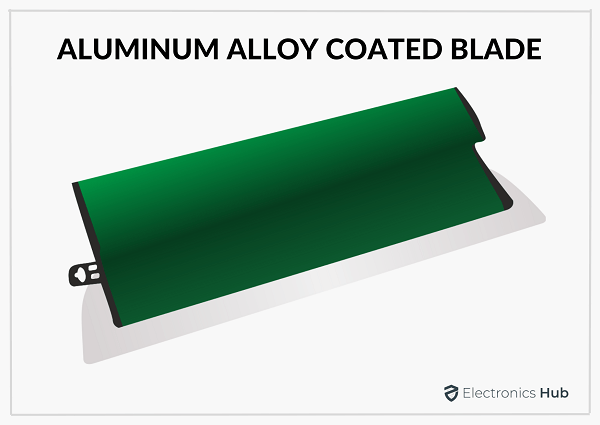
First, we have the Aluminum Alloy Coated Blade. This type of coating is one of the least-expensive options available. Aluminum Alloy Coated Blades are slightly more durable than regular blades.
11. Teflon-Coated Blade
You might have heard about Teflon coating in your kitchenware. This coating adds a non-stick layer to the material.
You can also find Teflon-coated Table Saw blades. The non-stick coating reduces the friction between the blade and the material and results in making a clean cut.
The average temperature of a Teflon-coated Table Saw Blade is significantly less than other types of blades and at the same time, they don’t rust.
12. Nickel-Plated Blade
Another popular way to make Table Saw Blades stronger and more durable is to electroplate them with Nickel. The main benefit of Nickel-plated Blades is they are corrosion-resistant (thanks to Nickel).
Apart from this, the Nickel-plated blade can also resist the build-up of heat. This in turn means these blades can run for a long time.
13. Carbide-Tipped Blade
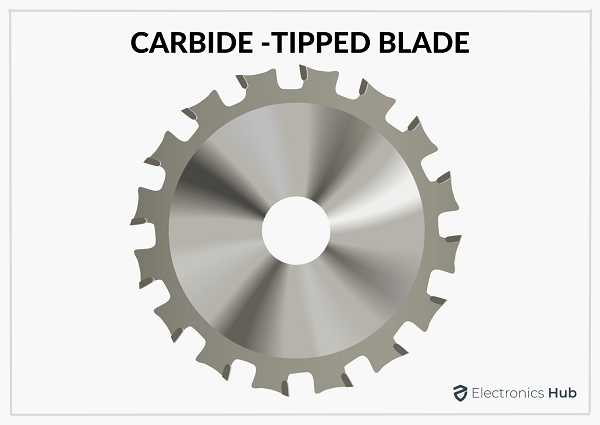
In the Carbide-Tipped type, we further have two extensions in the form of Tungsten Carbide and Titanium Carbide. Tungsten Carbide-Tipped Blades are durable and high-resistant to heat.
Titanium Carbide-Tipped Blades are very strong. We can use all these Carbide-tipped Blades on all kinds of materials, especially thick and dense metals. The Carbide-tipped Blades can produce very smooth cuts even in hard metals.
14. Diamond-Tipped Blade
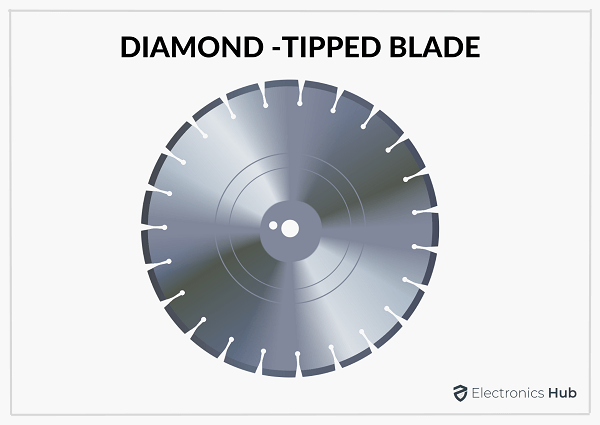
Putting that aside, Diamond-tipped Blades are one of the toughest blades available today. They can cut through hard and dense materials such as concrete, masonry, metals, stone, etc.
Apart from tough materials, we can also use Diamond-tipped Blades on delicate items such as glass, ceramic, etc.
Conclusion
Table Saw is the main centerpiece in many workshops. Its main application is to make long cuts in lumber (or plywood) where the blade runs parallel to the grain of the wood.
Speaking of blades, there are several types of table saw blades that have very specific applications. In this guide, we saw the basic terminology associated with the table saw blades.
After that, we looked at 14 different types of table saw blades along with their typical applications. If you feel that we missed anything or want us to add something, do let us know in the comments section below. It will not only help us but even other readers.

